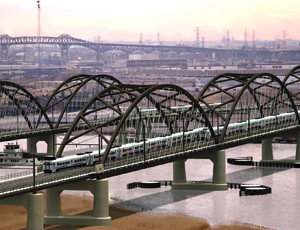Applications are in for the first batch of federal high-speed-rail grants financed largely by $8 billion in American Recovery and Reinvestment Act funds. An unofficial round-one tally shows states are seeking about $6.6 billion. That is far below the $102.5 billion in “pre-applications” states filed in July, but it reflects the first round’s emphasis on individual projects that are ready to start. Moreover, with the construction industry struggling, the new applications represent a substantial amount of potential infrastructure work, including bright possibilities for engineering firms. The dollars are expected to be even larger in the next round of applications, which will cover high-speed corridor plans.


The Federal Railroad Administration at ENR press time had not released an official count of round one applications received and dollars requested by the Aug. 24 deadline. But the blog Transport Politic says a survey of public announcements shows at least 19 states had applied for a total of $6.61 billion. FRA now will begin to evaluate the submissions and plans to announce the winners in October.
“This first round is going to be really focused on the recovery side of the recovery act,” says Karen Rae, FRA deputy administrator. She says that means “projects that are ready to go.”
The federal program includes four grant categories, or “tracks.” Round one includes Tracks 1, 3 and 4. Track 1 grants will fund final design or construction of projects that are ready to begin and can be finished within two years of the grant award. Track 1 projects would receive up to100% federal funding but must have completed preliminary engineering and National Environmental Policy Act (NEPA) documentation, such as a final environmental impact statement. Track 1 grants also can fund contracts to complete the environmental studies and preliminary engineering for such projects.
Track 3 aid is for advance planning and requires a minimum 50% nonfederal matching share. Track 4 grants give states another way to finance individual ready-to-go projects but require at least a 50% nonfederal match.
“To the extent that the pre-applications represented a vision of where states want to go in high-speed rail, I think the Track 1 applications represent a much more realistic view of what is actually ready for construction and implementation,” says one industry official. The source adds that FRA “got the message out that NEPA is real, that it cannot be ignored....I think that severely limited the dollar volume of projects that could be implemented within a two-year time frame.”
The dollars are expected to go up in the rail competition’s next round, for Track 2 grants funding new high-speed corridors. Rae says, “We think the bigger bang will come in the corridor projects,” for which applications are due on Oct. 2. Al Engel, AECOM vice president and director for U.S. high-speed rail, says the corridor proposals will be much larger than those in the first round. “We go up another three orders of magnitude,” Engel says. “We’re calibrating in billions.”
Still, the first-round applications aren’t chicken feed. Texas is seeking what appears to be the largest amount, $1.8 billion. Of that, $1.7 billion is for the “Texas T-Bone” plan, which includes a line from the...



Post a comment to this article
Report Abusive Comment